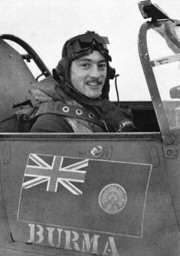No. 257 Squadron RAF
No. 257 Squadron RAF was a flying squadron of the Royal Air Force active during the First World War, the Second World War and also the Cold War. It was finally disbanded in December 1963.
| No. 257 (Burma) Squadron RAF | |
|---|---|
| Active | 18 August 1918 - 30 June 1919 17 May 1940 - 5 March 1945 1 September 1946 - 31 March 1957 1 July 1960 – 31 December 1963 |
| Country | |
| Branch | |
| Nickname(s) | Burma |
| Motto(s) | Burmese: Thay myay gyee shin shwe hti ("Death or glory") |
| post 1950 aircraft insignia |  |
| Commanders | |
| Notable commanders | Robert Stanford Tuck |
| Insignia | |
| Squadron Badge | A Chinthe sejant[1] |
| Squadron Codes | ML (May 1940 - Jun 1940) DT (Jun 1940 - May 1941) FM (May 1941 - Mar 1945) A6 (Sep 1946 - 1951) |
History
In World War I
No. 257 Squadron was formed at Dundee on 18 August 1918[1] from Nos. 318 and 319 Flights. It flew both seaplanes and flying boats on anti-submarine patrols from Dundee until the end of the First World War and disbanded there on 30 June 1919.[2]
In World War II

The squadron was re-formed on 17 May 1940 at RAF Hendon[1] as a Fighter Squadron, equipped with Spitfires. The squadron became operational at RAF Northolt, where the squadron flew Hurricanes in the Battle of Britain, during which it was part of No. 11 Group RAF. The squadron was based in south-east England throughout the Battle of Britain and in March began taking part in sweeps over France. Night fighter patrols were also flown and in July 1942 converted to Typhoons which began low-level patrols in September to intercept enemy fighter-bomber raids. Escort missions were also flown and in July 1943, it began offensive operations. The squadron started fighter-bombing sorties in January 1944, and as part of Second Tactical Air Force moved to France in July to provide air support for the Allied armies. By October it was based in Belgium for attacks on enemy transport and battlefield targets. The Squadron disbanded on 5 March 1945.[2]
During the Second World War the squadron was the Burma gift squadron; the chinthe in its logo is a Burmese effigy.[3]
Post War
On 1 September 1946 the squadron was re-formed at RAF Church Fenton[4] as a fighter squadron, flying Gloster Meteors until January 1955. It then converted to Hawker Hunters. On 31 March 1957 the squadron was disbanded for the third time.[2]
On Bloodhounds
The squadron re-emerged on 1 July 1960 at RAF Warboys[4] as an air defence unit using Bristol Bloodhound missiles till 31 December 1963, when the squadron was disbanded for the fourth, and final time.[2]
See also
References
Notes
- Halley 1988, p. 324.
- Jefford 2001, p. 81.
- Rawlings 1978, p. 363.
- Halley 1988, p. 325.
Bibliography
- Halley, James J. The Squadrons of the Royal Air Force & Commonwealth, 1981-1988. Tonbridge, Kent, UK: Air-Britain (Historians) Ltd., 1988. ISBN 0-85130-164-9.
- Jefford, C.G. RAF Squadrons, a Comprehensive Record of the Movement and Equipment of all RAF Squadrons and their Antecedents since 1912. Shrewsbury, Shropshire, UK: Airlife Publishing, 2001. ISBN 1-84037-141-2.
- Rawlings, John D.R. Coastal, Support and Special Squadrons of the RAF and their Aircraft. London: Jane's Publishing Company Ltd., 1982. ISBN 0-7106-0187-5.
- Rawlings, John D.R. Fighter Squadrons of the RAF and their Aircraft. London: Macdonald and Jane's (Publishers) Ltd., 1978. ISBN 0-354-01028-X.
- Robinson, Anthony. RAF Squadrons in the Battle of Britain. London: Arms and Armour Press Ltd., 1987 (republished 1999 by Brockhampton Press, ISBN 1-86019-907-0.).
| Wikimedia Commons has media related to No. 257 Squadron RAF. |
